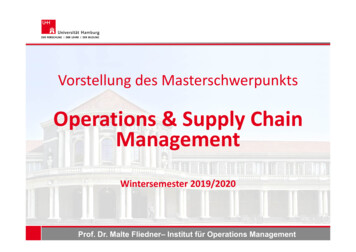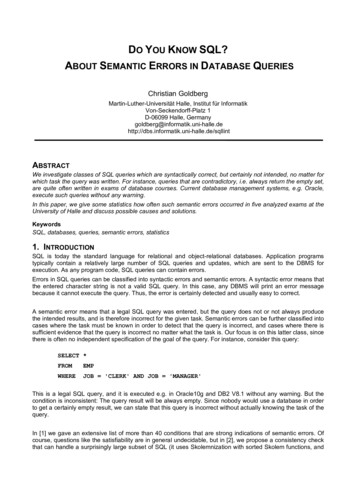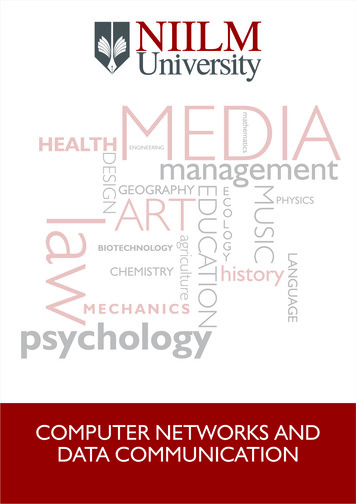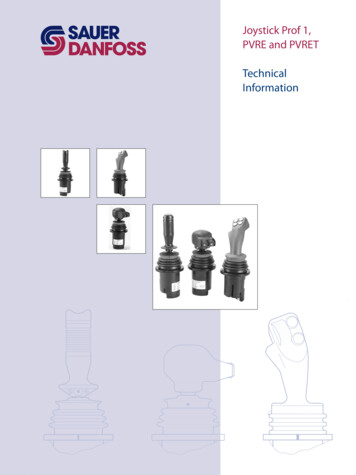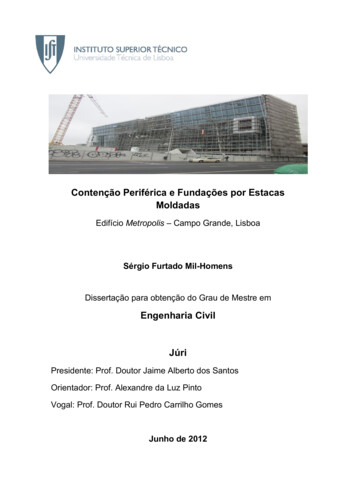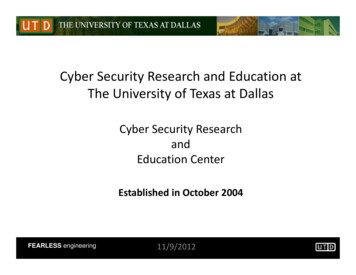
Transcription
CSMC 417Computer NetworksProf. Ashok K Agrawala 2016 Ashok AgrawalaSept 16CMSC417 Set 11
General Instructor - Ashok K. Agrawala– agrawala@cs.umd.edu– 4149 AVW TA – Andrew Pachulski– Office Hours – Class Meets – Tu Th 12:30 – 1:45 CSIC 3117Sept 16CMSC417 Set 12
Prerequisite Required Background– must have 351 and 330 (412 or 430 would be helpful) Expectations– Understand the basics of Computer Architecture– Experience in implementing non-trivial systems-type projects– Should know Processor Memory Kernel vs. user process– Familiar with basic probabilitySept 16CMSC417 Set 13
Expectations – After the course Understand the fundamentals of networking protocols, includingprotocol layering, basic medium access including wireless protocols,routing, addressing, congestion control Understand the principles behind the Internet protocols and someapplication layer protocols such as http, ftp, and DNS, and a few peerto-peer systems/protocols such as Gnutella and Chord. Understand some of the limitations of the current Internet and itsservice model Understand the causes behind network congestion, and explain thebasic methods for alleviating congestion Design, implement, and test substantial parts of network protocolsSept 16CMSC417 Set 14
Announcements Required Work– will require about the same amount of effort as 412 412 a (slightly) harder project to debug 417 project is (by design) more ambiguous Required Texts––Sept 16Computer Networks 5th Edition, Tanenbaum and Wetherall, Prentice Hall 2011. ISBN 0-13-212695-8TCP/IP Sockets in C: A Practical Guide for Programmers 2nd Edition by Jeff Donahoo and KenCalvert,Morgan Kaufmann, 2009. ISBN 978-0123745408CMSC417 Set 15
Other Material Recommended Texts– Computer Networking, 5e: A Top Down Approach Featuring theInternet by Jim Kurose and Keith Ross, Addison-Wesley, (ISBN: 0-13607967). The on-line version of this book is athttp://www.awlonline.com/kurose-ross.– Computer Networks: A Systems Approach by Larry Peterson and BruceDavie, MorganKaufman, 4rd Edition, 2007. ISBN 978-0123705488– An Engineering Approach to Computer Networking, by S. Keshav.Addison-Wesley,1997. ISBN 0-201-63442-2– Computer Networking with Internet Protocols by William Stallings,Prentice-Hall, 2004. ISBN 10: 0131410989– TCP/IP Illustrated volume 1 by W. Richard Stevens. Addison-Wesley.ISBN: 0-201- 63346-9. RFCsSept 16CMSC417 Set 16
Grading Final 25%In-Term Exam(s) 25%Programming Assignments 35%Class Participation 15%– Learning Reports– Pop Quizzes– Sept 16CMSC417 Set 17
Learning Reports Usually once a week– At the end of the class– When I ask you to One page––––Sept 16Your name and dateWhat you learned this week/this class as askedWhat concept you found difficultAny comments for me.CMSC417 Set 18
What is this course all about? Computer Networking– ?UserAUserBComputerAComputerBInternetSept 16CMSC417 Set 19
Block Diagram of Typical sMemory(RAM )HarddiskCD/DVDnetwork/wireless(and chive/fall11/cos109/02inside.pdfSept 16CMSC417 Set 110
Motherboard ( fall11/cos109/02inside.pdfSept 16CMSC417 Set 111
Backplane ( fall11/cos109/02inside.pdfSept 16CMSC417 Set 112
Some CPU chips2.5" laptop all11/cos109/02inside.pdfSept 16CMSC417 Set 113
Sept 16CMSC417 Set 114
Sept 16CMSC417 Set 115
Sept 16CMSC417 Set 116
Sept 16CMSC417 Set 117
Sept 16CMSC417 Set 118
Internet Statistics 2016 There are 3.26 billion internet users as at December 2015; that’s over 40% of the world population.Asia, as a continent, has the most internet users. It accounts for 48.4% of global internet users.China, as a country, has the most internet users; with an estimated 640 million internet users, thenumber of internet users in China is twice the number of the entire U.S population.China has the highest percentage of internet users (21.97%), followed by the U.S. (9.58%) and India(8.33%).Bermuda has the highest internet penetration at 97.75%; a whopping 63,987 of Bermuda’s 65,461population uses the internet.In contrast, while a whopping 86.75% of the U.S. population uses the internet, the U.S. is only ranked#25 in terms of internet penetration. The U.K. ranks #15 in terms of internet penetration with anestimated 89.90% of U.K. citizens using the internet.Digital interactions influenced retail sales to the tune of 2.2 trillion in 2015.By 2017, there will be more internet traffic than all prior internet years combinedWi-Fi and mobile-connected devices will generate 68% of all internet traffic by 2017.In 2015, 64% of all in-store sales, or sales to the tune of 2.2 trillion, were influenced by the internet.Facebook now has 1.55 billion active users.2.9 billion Google searches are made every day.2.7 million blog posts are published every day.Sept 16CMSC417 Set 119
Domain Name Statistics 2016 There are currently 123.78 million registered .comdomain names, making the .com TLD the top domainname extension. This is followed by the .tk TLD with27.7 million registered domain names. The .com TLD accounts for 50% of all registered TLDs. As of November 2015, there are a total of 1096 TLDs. The most expensive domain name ever sold isInsurance.com, for 35.6 million in 2010.Sept 16CMSC417 Set 120
Web Hosting and Website 2016 There are currently 966 million websites in the world today.Sept 16CMSC417 Set 121
Web Hosting and Website 2016 The highest number of websites connected to internet was 1 billion; this happened inSeptember 2014, but the number eventually declined and is expected to be achievable againby mid 2016.The world’s first website was published on August 6, 1991 by British physicists Tim BernersLee.Only 44% of web traffic is from humans; a massive 56% of web traffic is from bots,impersonators, hacking tools, scrapers and spammers.39% of web servers are hosted on Apache.Google is the #1 most popular website in the world, followed by Facebook and YouTube.The average e-commerce site takes 7.12 seconds to load in Internet Explorer 9, an average of7.15 seconds to load in Firefox 7 and an average of 7.5 seconds to load in Google Chrome.Google uses site speed as a ranking factor.The most popular CMS is WordPress, powering 25.4% of all websites in the world andresponsible for over 76.5 million blogs.An estimated 37,000 websites are hacked every day.Sept 16CMSC417 Set 122
Sept 16CMSC417 Set 123
E-commerce and Conversion Statistics 2016 40% of global internet users, or more than 1 billion people, havebought products or goods online. The U.S. e-commerce economy is worth 349 billion while China’s ecommerce economy is worth 562.66 billion. A single second delay in your website loading time can result in a 7%loss in conversion, and 40% of web users will abandon a website if ittakes longer than 3 seconds to load. Slow loading websites cost the U.S. e-commerce market more than 500 billion annually. Online retail sales in the U.K. reached an estimated 52.25 billion in2015, with the average shopper spending 1,174. Worldwide B2C e-commerce sales reached 1.7 trillion in 2015, andit is estimated to reach 2.35 trillion by 2018. 8 out of 10 consumers will shop online if offered free shipping.Sept 16CMSC417 Set 124
E-commerce and Conversion Statistics 2016 Personalized recommendations can increase conversion rates by up to 5.5 times.51% of U.S. online shoppers cite slow site loading times as the top reason theyabandon a purchase.34% of British consumers cite a store’s reputable brand name for being their reasonfor shopping with a brand, while 38% cite social media interaction as their reasonfor visiting a retailer’s website.40% of shoppers consult 3 or more channels, often in the process of shopping,before making a purchase; that’s a massive increase from 10% in 2002, and it goesto show the increasing importance of having an online presence in as many placesas possible.While mobile internet usage is high, desktop and tablet internet usage still leadsfor conversions; an estimated 8.52% of desktop users add to cart and an estimated2.78% convert to sales. This is much higher than Smartphone conversion rates withan estimated 4.70% add to cart rate and an estimated 0.80% sales conversion rate.The number is much higher when you consider conversion rates from tablets andother mobile devices, but desktop still leads when it comes to actual sales.An increase in site speed from 8 to 2 seconds can boost your conversion rate by74% (this is based on data monitoring real user activity from 33 major retailers).Sept 16CMSC417 Set 125
E-commerce and Conversion Statistics 2016 Increasingly shrinking attention span keeps influencing ecommerce; in 2010, a page that took 6 seconds to loadsuffered a 40% loss in conversion. Today, a page that takes 6seconds to load will experience a 50% loss in conversion. The abandonment rate for mobile shopping cart is higher (at97%) than that of desktop shopping carts (at 70 – 75%). E-commerce sales from social media grew by 202% in 2014,and is expected to further increase. The average human attention span has declined from 12seconds in the year 2000 to 8 seconds now. This is muchshorter than the attention span of a goldfish (at 9 seconds).This was revealed by a recent study by Microsoft Corp. thatsurveyed 2,000 people and monitored brain activity of 112others using electroencephalograms (EEGs).Sept 16CMSC417 Set 126
Mobile Internet 2016 There are more mobile internet users than desktop internet users; 52.7% of global internet users accessthe internet via mobile, and 75.1% of U.S. internet users access the internet via mobile.Mobile media time in the U.S. has exceeded desktop, with mobile media time estimated to be 51% whiledesktop media time is estimated to be 42%.While there are more mobile users than desktop users, mobile advertising spend is still slightly lower thandesktop advertising spend; mobile advertising spend currently represents 49% of digital advertising spend,compared to desktop at 51%.Mobile advertising spend is projected to account for 60.4% of all digital advertising spend by 2016 and72.2% of all digital advertising spend by 2019.In 2015, mobile influenced retail sales to the tune of over 1 trillion.Search engines are the starting point for mobile research, with an estimated 48% of mobile internet usersstarting their search on search engines.Consequently, the #1 search engine, Google started to significantly use mobile compatibility as a factorwhen ranking websites.B2C mobile commerce sales in the U.S. is valued at an estimated 83.93 billion.4 out of 5 consumers use a Smartphone to shop.70% of mobile searches result in an online action within an hour of the search being conducted.50% of mobile users will abandon of web page if it takes more than 10 seconds to load, and 60% won’treturn to the site.Sept 16CMSC417 Set 127
Sept 16CMSC417 Set 128
Sept 16CMSC417 Set 129
Sept 16CMSC417 Set 130
Social Issues– Network neutrality – no networkrestrictions– Content ownership, e.g., DMCA takedowns– Anonymity and censorship– Privacy, e.g., Web tracking and profiling– Theft, e.g., botnets and phishingCMSC417 Set 1
Network TypesNetworks can be classified by their scale:ScaleTypeVicinityPAN (Personal Area Network) »BuildingLAN (Local Area Network) »CityMAN (Metropolitan Area Network) »CountryWAN (Wide Area Network) »PlanetThe Internet (network of all networks)CMSC417 Set 1
Personal Area NetworkConnect devices over the range of a personExample of a Bluetooth (wireless) PAN:CMSC417 Set 1
Local Area Networks Connect devices in a home or office building Called enterprise network in a companyWired LAN withswitched EthernetWireless LANwith 802.11Sept 16CMSC417 Set 140
Local Area Networks Two broadcast networks (a) Bus (b) RingSept 16CMSC417 Set 141
Metropolitan Area NetworksConnect devices over a metropolitan areaExample MAN based on cable TV:CMSC417 Set 1
Wide Area Networks Relation between hosts on LANs and the subnet.Sept 16CMSC417 Set 143
Wide Area Networks (2) A stream of packets from sender to receiver.Sept 16CMSC417 Set 144
Broadcast Networks Types of transmission technology Broadcast links Point-to-point linksSept 16CMSC417 Set 148
Broadcast Networks (2) Classification of interconnected processors by scale.Sept 16CMSC417 Set 149
Wireless Networks Categories of wireless networks: System interconnection Wireless LANs Wireless WANsSept 16CMSC417 Set 150
Wireless Networks (2)Sept 16 (a) Bluetooth configuration (b) WirelessLANCMSC417 Set 151
Wireless Networks (3)Sept 16 (a) Individual mobile computers (b) A flying LANCMSC417 Set 152
Home Network Categories Computers (desktop PC, PDA, shared peripheralsEntertainment (TV, DVD, VCR, camera, stereo, MP3)Telecomm (telephone, cell phone, intercom, fax)Appliances (microwave, fridge, clock, furnace, airco)Telemetry (utility meter, burglar alarm, babycam).Sept 16CMSC417 Set 153
Network Software– Protocol layers »– Design issues for the layers »– Connection-oriented vs. connectionlessservice »– Service primitives »– Relationship of services to protocols »CMSC417 Set 1
Protocol Layers (1)Protocol layering is the main structuring methodused to divide up network functionality. Each protocol instancetalks virtually to its peer Each layer communicatesonly by using the onebelow Lower layer services areaccessed by an interface At bottom, messages arecarried by the mediumCMSC417 Set 1
Protocol Layers (2) Example: the philosopher-translator-secretaryarchitecture Each protocol at different layers serves a differentpurposeSept 16CMSC417 Set 156
Protocol Layers (3) Each lower layer adds its own header (with controlinform-ation) to the message to transmit and removes iton receive Layers may also split and join messages, etc.Sept 16CMSC417 Set 157
Design Issues for the LayersEach layer solves a particular problem butmust include mechanisms to address a setof recurring design issuesIssueExample mechanisms at different layersReliability despitefailuresCodes for error detection/correction (§3.2, 3.3)Routing around failures (§5.2)Network growthand evolutionAddressing (§5.6) and naming (§7.1)Protocol layering (§1.3)Allocation of resourceslike bandwidthMultiple access (§4.2)Congestion control (§5.3, 6.3)Security againstvarious threatsConfidentiality of messages (§8.2, 8.6)Authentication of communicating parties (§8.7)CMSC417 Set 1
Connection-Oriented vs.Connectionless Service provided by a layer may be kinds of either:– Connection-oriented, must be set up for ongoing use (andtorn down after use), e.g., phone call– Connectionless, messages are handled separately, e.g.,postal deliverySept 16CMSC417 Set 159
Service Primitives (1) A service is provided to the layer above as primitives Hypothetical example of service primitives that mayprovide a reliably byte stream (connection-oriented)service:Sept 16CMSC417 Set 160
Service Primitives (2) Hypothetical example of how these primitives maybe used for a client-server interactionServerClientLISTEN (0)CONNECT (1)Connect requestAccept responseSEND (3)RECEIVEACCEPT (2)RECEIVERequest for dataSEND (4)ReplyDISCONNECT (5)DisconnectDISCONNECT (6)DisconnectSept 16CMSC417 Set 161
Service Primitives (2)Sept 16 Packets sent in a simple client-server interaction ona connection-orientednetwork.CMSC417 Set 162
Relationship of Services to ProtocolsRecap:– A layer provides a service to the oneabove[vertical]– A layer talks to its peer using a protocol[horizontal]CMSC417 Set 1
Reference ModelsReference models describe the layers in anetwork architecture– OSI reference model »– TCP/IP reference model »– Model used for this text »– Critique of OSI and TCP/IP »CMSC417 Set 1
Reference ModelsThe OSIreferencemodel.Sept 16CMSC417 Set 165
OSI Reference Model A principled, international standard, seven layermodel to connect different systems– Provides functions needed by users– Converts different representations– Manages task dialogs– Provides end-to-end delivery– Sends packets over multiple links– Sends frames of information– Sends bits as signalsSept 16CMSC417 Set 166
The TCP/IP Reference Model Layers Link layerInternet layerTransport layerApplication layerSept 1667CMSC417 Set 1
TCP/IP Reference Model A four layer model derived from experimentation;omits some OSI layers and uses the IP as the networkIP is the“narrow waist”of the InternetProtocols are shown in their respective layersSept 16CMSC417 Set 168
Reference Models (2) The TCP/IP reference model.Sept 16CMSC417 Set 169
Reference Models (3) Protocols and networks in the TCP/IP model initially.Sept 16CMSC417 Set 170
Model Used in this CourseIt is based on the TCP/IP model but we callout the physical layer and look beyondInternet protocols.CMSC417 Set 1
Example Networks– The Internet »– 3G mobile phone networks »– Wireless LANs »– RFID and sensor networks »CMSC417 Set 1
The ARPANETSept 16 (a) Structure of the telephone system. (b) Baran’s proposeddistributed switching system. 78CMSC417 Set 1
The ARPANET (2) The original ARPANET design.Sept 16CMSC417 Set 179
NSFNET The NSFNET backbone in 1988.Sept 16CMSC417 Set 180
Internet (1)Before the Internet was the ARPANET, adecentralized, packet-switched network based onBaran’s ideas.Nodes are IMPs,or early routers,linked to hosts56 kbps linksARPANET topology in Sept 1972.CMSC417 Set 1
Internet (2)The early Internet used NSFNET (1985-1995) as itsbackbone; universities connected to get on theInternetT1 links(1.5 Mbps)NSFNET topology in 1988CMSC417 Set 1
Internet (4)Architecture of the InternetSept 16CMSC417 Set 184
3G Mobile Phone Networks (1)3G network is based on spatial cells; each cellprovides wireless service to mobiles within it via abase stationCMSC417 Set 1
Fourth-Generation MobilePhone Networks Technologies– WiMAX MAXWell Lab at UMd– LTE TDM Based Higher user level bandwidthSept 16CMSC417 Set 188
Ethernet Architecture of the original Ethernet.Sept 16CMSC417 Set 189
Wireless LANs (a) Wireless networking with a base station. (b) Ad hoc networking.Sept 16CMSC417 Set 190
Wireless LANs (2)Signals in the 2.4GHz ISM band vary in strength dueto many effects, such as multipath fading due toreflections requires complex transmission schemes, e.g., OFDMCMSC417 Set 1
Wireless LANs (3)Radio broadcasts interfere with each other,and radio ranges may incompletely overlap CSMA (Carrier Sense Multiple Access) designs areusedCMSC417 Set 1
Wireless LANs (4) A multicell 802.11 network.Sept 16CMSC417 Set 193
Ad hoc Networks Similar to Sensor Networks All nodes are equal– Some distinguished nodes may have servers/externalconnections Information moves from node to nodeSept 16CMSC417 Set 194
RFID and Sensor Networks (1)Passive UHF RFID networks everyday objects: Tags (stickers with not even a battery) are placed onobjects Readers send signals that the tags reflect tocommunicateCMSC417 Set 1
RFID and Sensor Networks (2)Sensor networks spread small devices over anarea: Devices send sensed data to collector via wirelesshopsCMSC417 Set 1
Network Standardization Who’s Who in the Telecommunications World Who’s Who in the International Standards World Who’s Who in the Internet Standards WorldSept 16CMSC417 Set 197
Network StandardizationStandards define what is needed forinteroperabilitySome of the many standards bodies:BodyAreaExamplesITUTelecommunicationsG.992, ADSLH.264, MPEG4IEEECommunications802.3, Ethernet802.11, WiFiIETFInternetRFC 2616, HTTP/1.1RFC 1034/1035, DNSW3CWebHTML5 standardCSS standardCMSC417 Set 1
ITU Main sectors Radiocommunications Telecommunications Standardization Development Classes of Members Sept 16National governmentsSector membersAssociate membersRegulatory agenciesCMSC417 Set 199
Who’s Who in International Standards (1)The 802 working groups. The important ones are marked with *.The ones marked with are hibernating. The one marked with †gave up and disbanded itself.Sept 16100CMSC417 Set 1
Who’s Who in International Standards (2)The 802 working groups. The important ones are marked with *.The ones marked with are hibernating. The one marked with †gave up and disbanded itself.Sept 16101CMSC417 Set 1
Metric UnitsThe main prefixes we use:Prefix Exp.prefix exp.K(ilo) 103m(illi) 10-3M(ega) 106μ(micro) 10-6G(iga) 109n(ano) 10-9– Use powers of 10 for rates, powers of 2 forstorage E.g., 1 Mbps 1,000,000 bps, 1 KB 1024 bytes– “B” is for bytes, “b” is for bitsCMSC417 Set 1
Metric Units The principal metric prefixes.Sept 16CMSC417 Set 1103
Metric Units (1)The principal metric prefixesSept 16104CMSC417 Set 1
Metric Units (2)The principal metric prefixesSept 16105CMSC417 Set 1
Aug 06, 1991 · –Computer Networking with Internet Protocols by William Stallings, Prentice-Hall, 2004. ISBN 10: 0131410989 –TCP/IP Illustrated volume 1 by W. Richard Stevens. Addison-Wesley. ISBN: 0-201-
